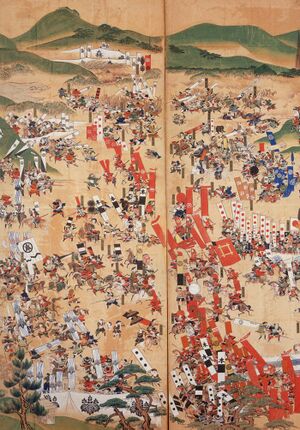Battle of Sekigahara
- Tokugawa Ieyasu (80,000) vs. Ishida Mitsunari (80,000)
- Date: 21 October, 1600
- Location: Mino province 35° 22' N / 136° 28' E
- Altitude: 429 feet / 130 meters
- KIA: Otani Yoshitsugu, Shima Sakon (died of wounds), Shimazu Toyohisa; (Tokugawa) Ii Naomasa (died of wounds)
The battle of Sekigahara was the decisive battle which is often said to mark the end of the Sengoku period, and the beginning of Tokugawa hegemony. Along with a number of clashes which preceded and followed Sekigahara, this battle saw followers and allies of Tokugawa Ieyasu (the so-called "Eastern Army") defeat the forces of numerous warlords united behind Ishida Mitsunari and Môri Terumoto. Tokugawa Ieyasu would then go on to further secure his position as hegemon, suppressing very nearly all opposition, and being named shôgun three years later.
Background
Prior to the death of Toyotomi Hideyoshi in 1598, Hideyoshi named five of his top generals, including Tokugawa Ieyasu, Ishida Mitsunari, and Môri Terumoto, to serve as regents for his young son, Toyotomi Hideyori. The five swore numerous oaths to protect Hideyori and his succession, to rule justly until Hideyori was old enough to rule on his own, and to ensure that Hideyori would, in fact, be made hegemon when he came of age.
Within a year after Hideyoshi's death and the Japanese withdrawal from Korea, however, most warlords across the realm began preparing for war. Though historian Morgan Pitelka suggests Ieyasu had no intentions originally to betray the pact, he writes that Ieyasu quickly grew frustrated with the restrictions these oaths placed upon him and his political life, e.g. that political marriages had to be brought before the Five Regents for their approval. Ieyasu took up residence in the Toyotomi castle at Osaka, and issued guidelines to his generals as to the defense of Edo, and the formation of a Tokugawa force.
Mitsunari, meanwhile, secured the allegiance of Môri Terumoto, and along with their various other allies issued a formal statement on 1600/7/17 declaring Ieyasu impeached as regent. The document cited numerous infractions against the Toyotomi oaths, and against proper political etiquette (e.g. in taking hostages, arranging marriages, etc.). Even before receiving this document, however, Ieyasu ordered his forces westward. While Ieyasu returned to Edo, his main force of some 43,000 men engaged with Ishida followers on the Nobi Plain (in the border regions of Mino and Owari provinces). Ieyasu's son Tokugawa Hidetada meanwhile led his 39,000 or so men down the Nakasendô highway. Ieyasu then headed west himself, departing Edo on 9/1 with an additional 30,000 men, making their way down the Tôkaidô with a minimum of pomp and circumstance; while it would have been impossible to hide such a force, this at least meant they were not explicitly announcing themselves, and it allowed them to travel much more quickly. Ieyasu met Ishida's forces at the Nakasendô post-station of Sekigahara on 9/15.
The Battle
This battle saw the culmination of the Sekigahara Campaign and the complete defeat of the ‘Western Army’. The battle was fought around a small village called Sekigahara that sat astride a crossroads under the heights of Mt. Sasao, Mt. Matsuo, and Mt. Nangu. In retrospect a strategically important point, the choice of the field of battle had been inadvertent. Ishida Mitsunari had hoped to meet Ieyasu somewhere further east; Ieyasu's primary objective had been Sawayama castle. Ieyasu's hasty march west forced Mitsunari to offer Ieyasu a fight the latter was more than willing to accept. At the same time, the ground favored Mitsunari to a degree. Western army troops occupied the heights around Mt. Nangu and Matsuo, with Ishida himself positioned somewhat northwest of Sekigahara and flanked by Mt. Sasao. Ieyasu's men were deployed along the Nakasendô, with the vanguard facing Mitsunari, and were exposed to an attack in the flanks, especially by the Western troops on Mt. Matsuo. Luckily for Ieyasu, those men were under the command of Kobayakawa Hideaki - who had already decided to betray his Western compatriots. The fighting began in a rainy dawn, and the outcome was initially very much in doubt. The forward Tokugawa units attacked and became heavily engaged with contingents under Ukita Hideie, Ôtani Yoshitsugu, and Konishi Yukinaga. No real advantage was gained until the defection of Kobayakawa Hideaki around noon. Hideaki, who commanded one of the strongest Western contingents present, turned the tide in Ieyasu’s favor. Meanwhile, the 25,000 or so Western troops arrayed on the slopes of Mt. Nangu under the Môri and Chôsokabe clans were largely idle. Kikkawa Tsunie, commanding the vanguard, had himself decided not to fight Ieyasu, and his immobility forced those to his rear to do the same. Finally, the Western forces began to break and a general rout ensued. By the end of the day's killing, Ishida Mistunari’s forces had scattered and as many as 60,000 heads were be taken. Tokugawa’s victory was owed in large part to Kobayakawa’s defection and the inactivity of the Môri contingents present. Ishida and Konishi Yukinaga were later captured and executed.
References
- Initial text from Samurai-Archives.com FWSeal & CEWest, 2005
- Morgan Pitelka, Spectacular Accumulation, University of Hawaii Press (2016), 120-122.
